An Improved Unscented Particle Filter Approach for Multi-Sensor Fusion Target Tracking
Abstract
1. Introduction
- Aiming at the problem that the traditional distributed fusion architecture cannot make better use of the advantages of radar and infrared sensors, this paper proposes an improved distributed fusion architecture, which effectively utilizes the advantages of radar and infrared sensors, thus improving tracking performance and avoiding tracking divergence.
- An adaptive tracking algorithm with good tracking accuracy, great real-time performance, and strong robustness is proposed. Although the traditional UPF method has high tracking accuracy, real-time performance is low due to the high computational complexity. Different from UPF, the IUPF can improve general calculation speed and tracking accuracy. The minimal skew simplex unscented transform (MSSUT) [19] and scaled unscented transform (SUT) [20] are utilized to effectively reduce the amount of calculation of sample selection, and a self-adaptive gain modification coefficient is defined to solve the low-accuracy problem caused by the sigma point reduction in this paper. By rewriting the formula for calculating the weight of importance, the problem of particle degradation can be solved.
- Applying IUPF to multi-target tracking, the proposed method is a simple JPDA algorithm with IUPF, which can deal with non-trivial nonlinear conditions and improve the accuracy.
2. Related Work and Problem Statement
2.1. Related Work
2.2. Target Motion Model
2.3. Radar and Infrared Sensor Observation Models
3. The IUPF Algorithm
4. Multi-Sensor Fusion Target Tracking Algorithm Based on IUPF
- (1)
- An improved distributed fusion model of radar and infrared sensors for single target tracking.
- (2)
- A multi-target tracking algorithm based on the JPDA algorithm and IUPF multi-sensor fusion.
4.1. Improved Distributed Multi-Sensor Fusion Model
4.2. IUPF with JPDA Algorithm for Multi-Target Tracking
- (1)
- For t = 1, …, m, we, respectively, calculate the prediction of the tth target state , covariance , and measurement by (5) to (9) and (18) and (19). Then, we perform space-time registration.
- (2)
- For t = 1, …,m, we conform the validated measurements (i.e., effective echo within the tracking threshold), and we set n = 1, …, mk, and mk is the number of the validated measurements. Then, we calculate , , , by (5) to (9) and (18) and (19).
- (3)
- We use the JPDA algorithm proposed in [18] to receive the association probabilistic of track-to-measurement. The hypothesis-conditioned distribution can be calculated by IUPF instead of Gaussian approximations in the standard JPDA. Then, we can obtain data association probability .
- (4)
- Filter update. We associate the measurement with the target and then recalculate each target state estimate and its covariance. Equations (10) and (13) are changed as
- (1)
- For m = 1, …, t, we can obtain the importance density function of multi-target by (24), then we selective resamples from . Then, we compute the state estimation of the tth target at time k.
- (2)
- Calculate the state estimation of each sensor through the above steps. Then, use the fuzzy similarity-based correlation algorithm proposed in [39] for track correlation.
- (3)
- Fuse tracks for associated tracks by (22) and (23) to calculate fused state estimation .
5. Simulation
5.1. Single Target Tracking Simulation Experiment
5.2. Multi-Target Tracking Simulation Experiment
6. Simulation Results Analysis
6.1. Single Target Tracking Simulation Analysis
6.2. Multi-Target Tracking Simulation Analysis
7. Conclusions
- In this paper, based on the advantages and disadvantages of radar and infrared sensors, an improved fusion architecture is proposed based on the traditional distributed fusion architecture. Simulation experiments show that multi-sensor fusion can perceive increasingly accurate information compared with single sensors, and greatly improves the tracking accuracy, while the improved distributed multi-sensor fusion architecture can make better use of the advantages and disadvantages of radar and infrared sensors.
- The IUPF algorithm greatly improves real-time performance while ensuring tracking accuracy, which is undoubtedly a good method for tracking systems with real-time requirements.
- The proposed multi-target tracking method is a simple JPDA algorithm with IUPF, which has good performance.
Author Contributions
Funding
Conflicts of Interest
References
- Anitha, R.; Renuka, S.; Abudhahir, A. Multisensor data fusion algorithms for target tracking using multiple measurements. In Proceedings of the 2013 IEEE International Conference on Computational Intelligence and Computing Research, Enathi, India, 26–28 December 2013; pp. 1–4. [Google Scholar]
- Ogle, T.L.; Blair, W.D.; Slocumb, B.J.; Dunham, D.T. Assessment of hierarchical multi-Sensor multi-target track fusion in the presence of large sensor biases. In Proceedings of the 2019 22th International Conference on Information Fusion (FUSION), Ottawa, ON, Canada, 2–5 July 2019; pp. 1–7. [Google Scholar]
- Mitchell, A.E.; Smith, G.E.; Bell, K.L.; Rangaswamy, M. Single target tracking with distributed cognitive radar. In Proceedings of the 2017 IEEE Radar Conference (RadarConf), Seattle, WA, USA, 8–12 May 2017; pp. 0285–0288. [Google Scholar]
- Huazhi, C.; Jian, R. A multitarget tracking algorithm based on radar and infrared sensor data fusion. In Proceedings of the IEEE International Conference on Communication Software & Networks, Xi’an, China, 27–29 May 2011; pp. 367–371. [Google Scholar]
- Bao, T.; Zhang, Z.; Sabahi, M.F. An improved radar and infrared sensor tracking fusion algorithm based on IMM-UKF. In Proceedings of the IEEE ICNSC, Banff, AB, Canada, 9–11 May 2019; pp. 420–423. [Google Scholar]
- Bavirisetti, D.P.; Dhuli, R. Fusion of infrared and visible sensor images based on anisotropic diffusion and karhunen-loeve transform. IEEE Sens. J. 2016, 16, 203–209. [Google Scholar] [CrossRef]
- Ma, K.; Zhang, H.; Wang, R.; Zhang, Z. Target tracking system for multi-sensor data fusion. In Proceedings of the 2017 IEEE 2nd Information Technology, Networking, Electronic and Automation Control Conference (ITNEC), Chengdu, China, 15–17 December 2017; pp. 1768–1772. [Google Scholar]
- Yang, Q.; Taylor, D.G.; Durgin, D.G. Kalman filter-based localization and tracking estimation for HIMR RFID systems. In Proceedings of the 2018 IEEE International Conference on RFID (RFID), Orlando, FL, USA, 10–12 April 2018; pp. 1–5. [Google Scholar]
- Oh, S.M. Multisensor fusion for autonomous UAV navigation based on the unscented Kalman filter with sequential measurement updates. In Proceedings of the IEEE Conference on Multisensor Fusion and Integration, Salt Lake City, UT, USA, 5–7 September 2010; pp. 217–222. [Google Scholar]
- Khazraj, H.; Da Silva, F.F.; Bak, C.L. A performance comparison between extended Kalman Filter and unscented Kalman Filter in power system dynamic state estimation. In Proceedings of the 2016 51st International Universities Power Engineering Conference (UPEC), Coimbra, Portugal, 6–9 September 2016; pp. 1–6. [Google Scholar]
- Wang, R.; Chen, Z.; Yin, F. Speaker tracking based on distributed particle filter and iterative covariance intersection in distributed microphone networks. IEEE J. Sel. Top. Signal Process. 2019, 13, 76–87. [Google Scholar] [CrossRef]
- Malcolm, R.; Salmond, D.J. Particle filter for track-before-detect of a target with unknown amplitude viewed against a structured scene. IET RadarSonar Navig. 2018, 12, 603–609. [Google Scholar]
- Du, G.; Zhang, P.; Liu, X. Markerless human–manipulator interface using leap motion with interval Kalman filter and improved particle filter. IEEE Trans. Ind. Inform. 2016, 12, 694–704. [Google Scholar] [CrossRef]
- Bi, H.; Ma, J.; Wang, F. An improved particle filter algorithm based on ensemble Kalman filter and Markov chain Monte Carlo method. IEEE J. Sel. Top. Appl. Earth Obs. Remote Sens. 2015, 8, 447–459. [Google Scholar] [CrossRef]
- Ullah, I.; Shen, Y.; Su, X.; Esposito, C.; Choi, C. A localization based on unscented Kalman filter and particle filter localization algorithms. IEEE Access 2020, 8, 2233–2246. [Google Scholar] [CrossRef]
- Wang, F.; Sun, F.; Zhang, J.; Lin, B.; Li, X. Unscented particle filter for online total image Jacobian Matrix estimation in robot visual servoing. IEEE Access 2019, 7, 92020–92029. [Google Scholar] [CrossRef]
- Xi, Y.-H.; Peng, H. MLP training in a self-organizing state space model using unscented Kalman particle filter. J. Syst. Eng Electron. 2013, 24, 141–146. [Google Scholar] [CrossRef]
- Fortmann, T.; Bar-Shalom, Y.; Scheffe, M. Sonar tracking of multiple targets using joint probabilistic data association. IEEE J. Ocean. Eng. 1983, 8, 173–184. [Google Scholar] [CrossRef]
- Julier, J.; Uhlmann, J.K. Reduced sigma point filters for the propagation of means and covariances through nonlinear transformations. In Proceedings of the 2002 American Control Conference, Anchorage, AK, USA, 8–10 May 2002; pp. 887–892. [Google Scholar]
- Julier, J.; Uhlmann, J.K. Unscented filtering and nonlinear estimation. Proc. IEEE 2004, 92, 401–422. [Google Scholar] [CrossRef]
- Van Der Merwe, R.; Doucet, A.; De Freitas, N.; Wan, E. The unscented particle filter. Adv. Neural Inf. Process. Syst. 2000, 13, 584–590. [Google Scholar]
- Gao, S.; Kang, M.; Li, L. Estimation of state-of-charge based on unscented Kalman particle filter for storage lithium-ion battery. J. Eng. 2018, 16, 1858–1863. [Google Scholar] [CrossRef]
- Zhang, H.; Miao, Q.; Zhang, X.; Liu, Z. An improved unscented particle filter approach for lithium-ion battery remaining useful life prediction. Microelectron. Reliab. 2018, 81, 288–298. [Google Scholar] [CrossRef]
- Zhao, F.; Ge, S.-S.; Zhang, J.; He, W. Celestial navigation in deep space exploration using spherical simplex unscented particle filter. IET Signal Process. 2017, 12, 463–470. [Google Scholar] [CrossRef]
- Ding, Z.; Wei, G.; Ding, X.; Lv, H. Scale-corrected minimal skew simplex sampling UKF for BLDCM sensorless control. Syst. Sci. Control Eng. 2015, 3, 340–350. [Google Scholar] [CrossRef]
- Zhan, R.; Xin, Q.; Wang, J.-W. Modified unscented particle filter for nonlinear Bayesian tracking. J. Syst. Eng. Electron. 2008, 19, 7–14. [Google Scholar] [CrossRef]
- Wang, H.; Nguang, S.K. Multi-target video tacking based on Improved Data Association and Mixed Kalman/H∞ Filtering. IEEE Sens. J. 2017, 16, 7693–7704. [Google Scholar] [CrossRef]
- Wang, Y.H.; Wang, J.K.; Wang, B. A modified multi-target tracking algorithm based on joint probability data association and Gaussian particle filter. In Proceedings of the Intelligent Control & Automation IEEE, Shenyang, China, 29 June–4 July 2014; pp. 2500–2504. [Google Scholar]
- He, S.; Shin, H.; Tsourdos, A. Multi-sensor multi-target tracking using domain knowledge and clustering. IEEE Sens. J. 2018, 18, 8074–8084. [Google Scholar] [CrossRef]
- Yang, Y.-X.; He, H.-B. Adaptively robust filtering for kinematic geodetic positioning. J. Geo Desy 2001, 75, 109–116. [Google Scholar] [CrossRef]
- Yang, Y.-X.; Gao, W.-G. A new learning statistic for adaptive filter based on predicted residuals. Prog. Nat. Sci. 2006, 16, 833–837. [Google Scholar]
- Kwak, N.; Kim, I.-K.; Lee, H.-C.; Lee, B.-H. Analysis of resampling process for the particle depletion problem in FastSLAM. In Proceedings of the RO-MAN 2007-The 16th IEEE International Symposium on Robot and Human Interactive Communication, Jeju, South Korea, 26–29 August 2007; pp. 200–205. [Google Scholar]
- Liu, J.-S. Metropolized independent sampling with comparisons to rejection sampling and importance sampling. Stats Comput. 1996, 6, 113–119. [Google Scholar] [CrossRef]
- Doucet, A.; Godsill, S.; Andrieu, C. On sequential Monte Carlo sampling methods for Bayesian filtering. Stats Comput. 2000, 10, 197–208. [Google Scholar] [CrossRef]
- Park, W.J.; Kang, C.H.; Kim, S.Y.; Park, C.G. Asynchronous multi-sensor data fusion with decentralized IMM-PDAF. In Proceedings of the 2018 IEEE International Conference on Industrial Engineering and Engineering Management (IEEM), Bangkok, Thailand, 6–19 December 2018; pp. 1811–1815. [Google Scholar]
- Lin, H.; Sun, S. Optimal sequential fusion estimation with stochastic parameter perturbations, fading measurements, and correlated noises. IEEE Trans. Signal Process. 2018, 66, 3571–3583. [Google Scholar] [CrossRef]
- Yang, X.; Zhang, W.; Yu, L.; Xing, K. Multi-rate distributed fusion estimation for sensor network-based target tracking. IEEE Sens. J. 2016, 16, 1233–1242. [Google Scholar] [CrossRef]
- Mutambara, A.G. Decentralized Estimation and Control for Multisensor Systems; CRC Press: Boca Raton, FL, USA, 1998. [Google Scholar]
- Shi, Y.; Zhang, K.; Zhang, T.; Lin, N.; Zhao, Y.; Zhao, Y. An adaptive track fusion approach with fuzzy computation for multi-sensor. In Proceedings of the 2018 IEEE International Conference on Smart Internet of Things (SmartIoT), Xi’an, China, 17–19 August 2018; pp. 245–249. [Google Scholar]
- Zhu, M.; Xi, C.; Li, Y.; Bano, S.; Zhang, Z.; Liu, Y.; Yagubov, R. Truck Active Reversing Control Strategy Based on Modified Particle Filter and Multi-sensors Environment Perception. IET Intelligent. Trans Syst. 2019, 13, 1057–1068. [Google Scholar] [CrossRef]
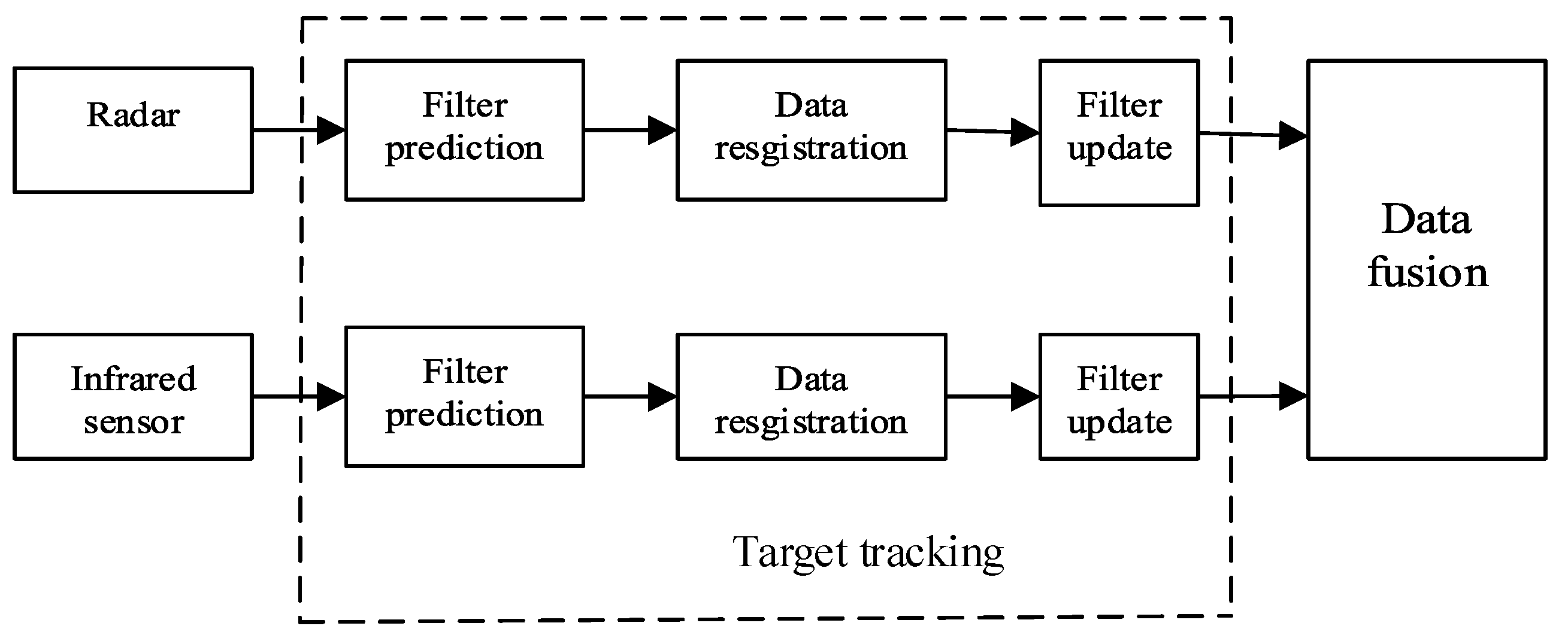
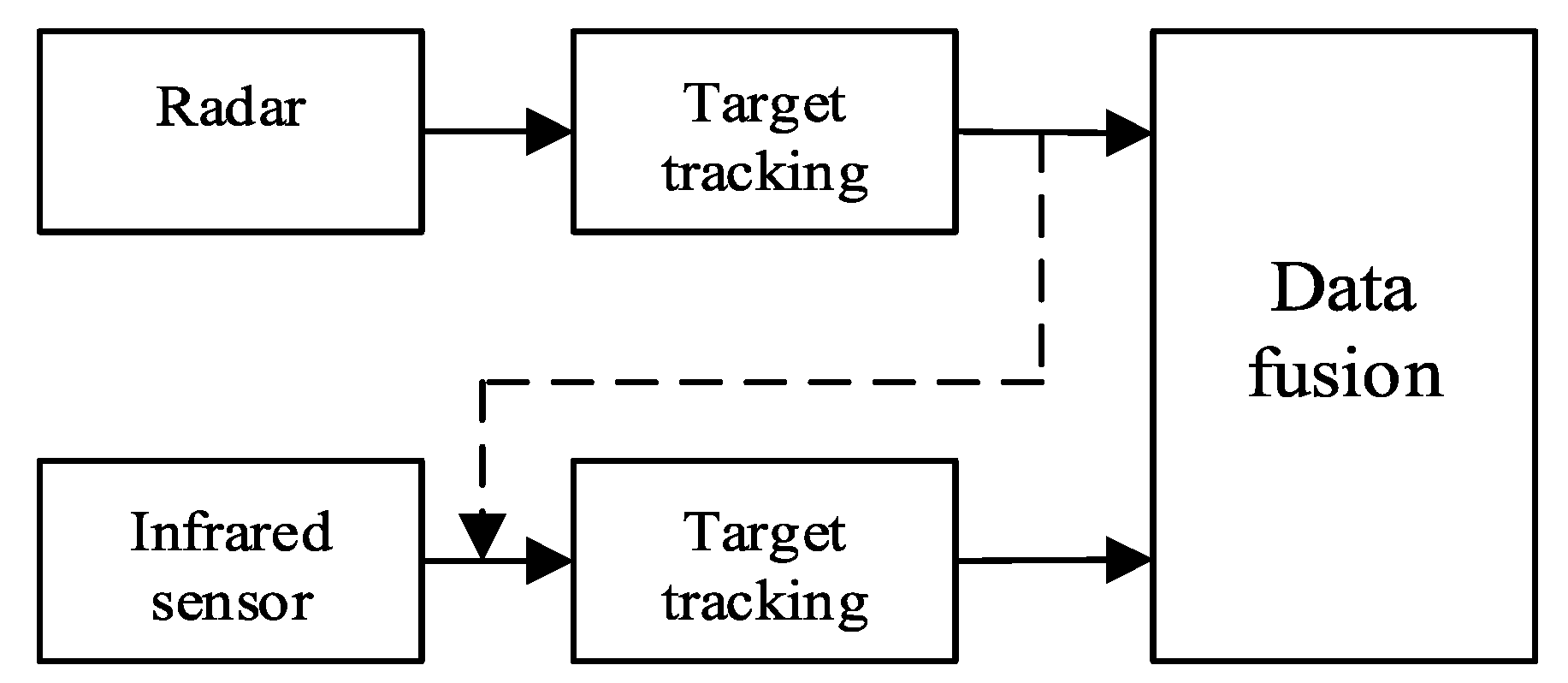

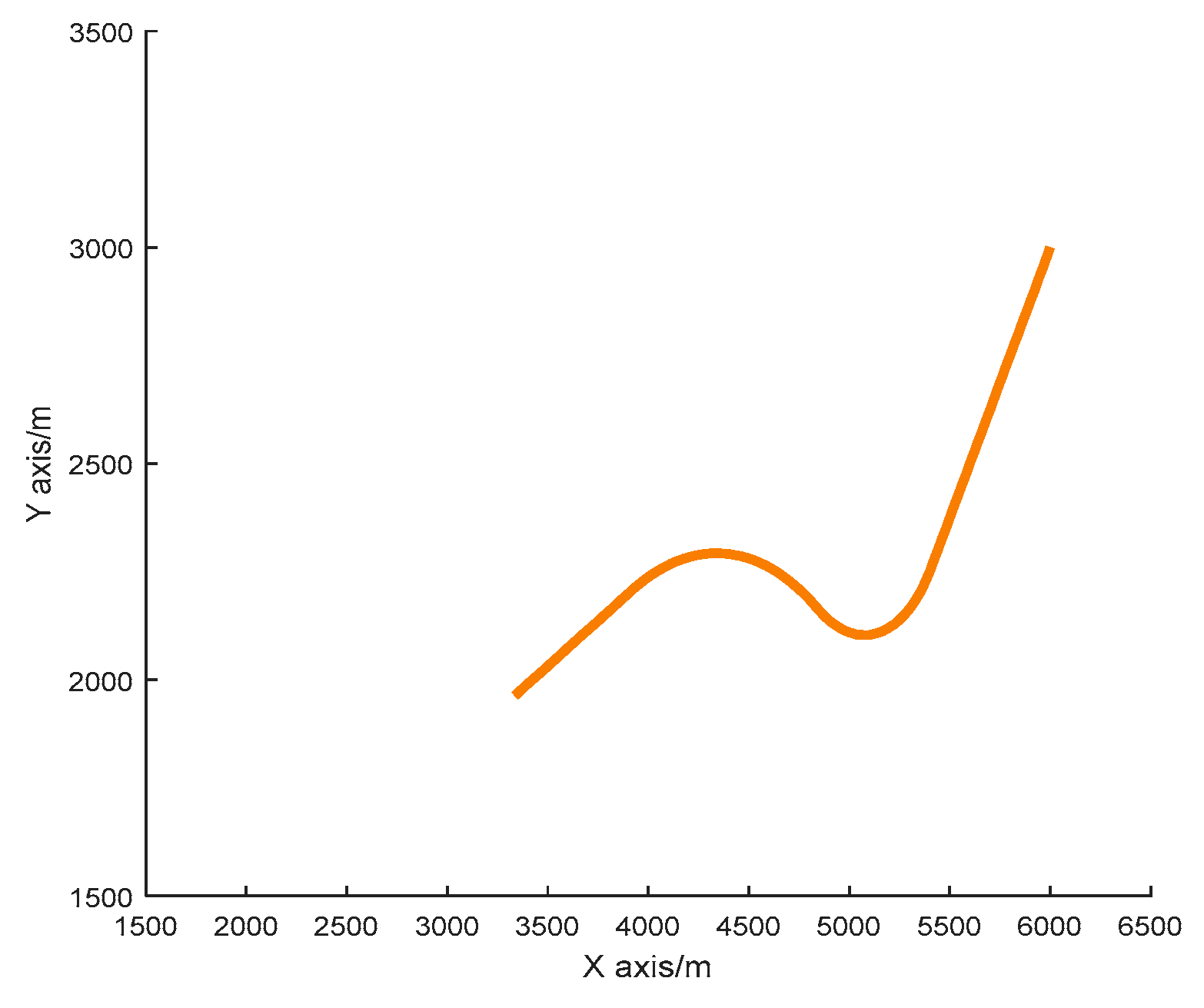

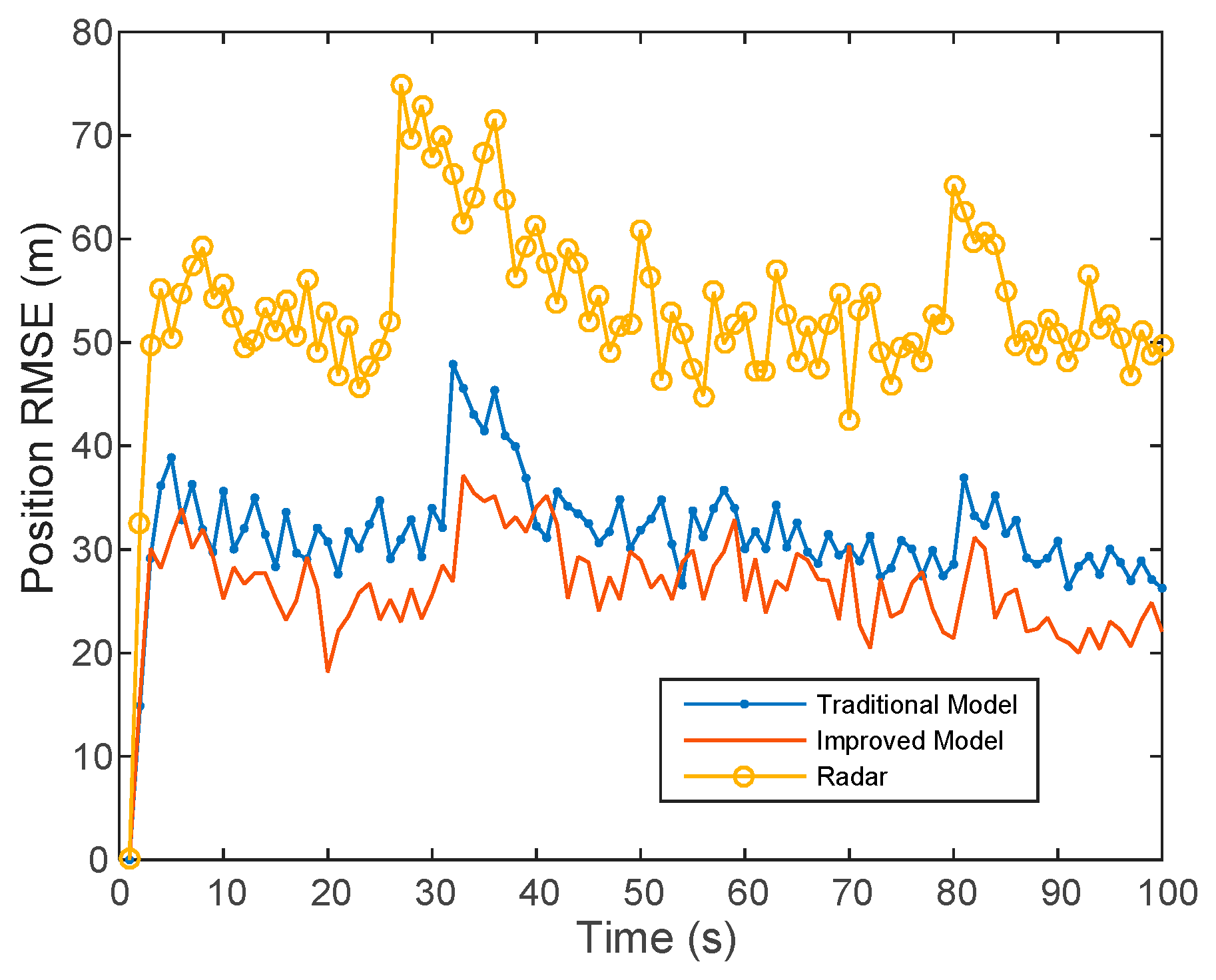
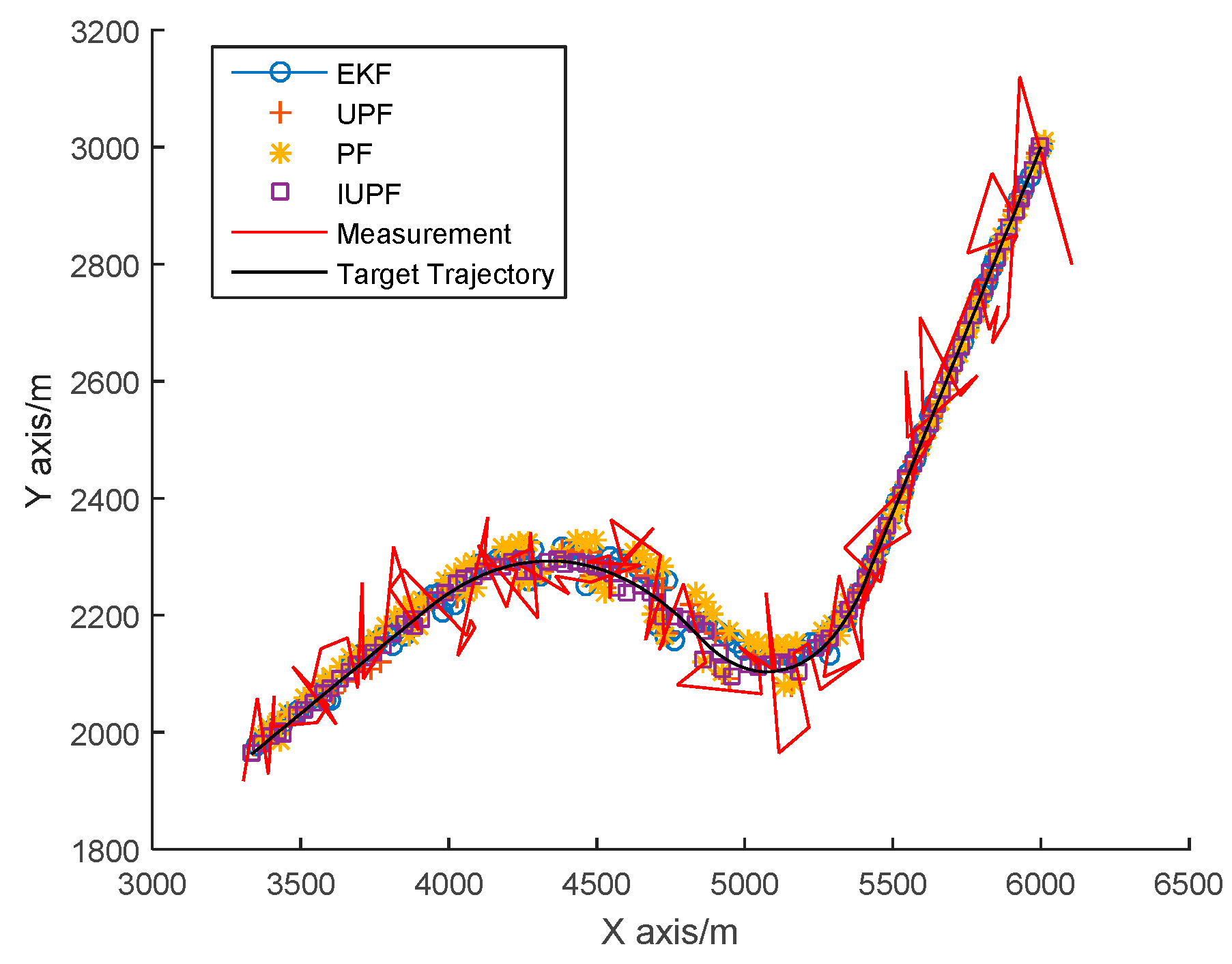

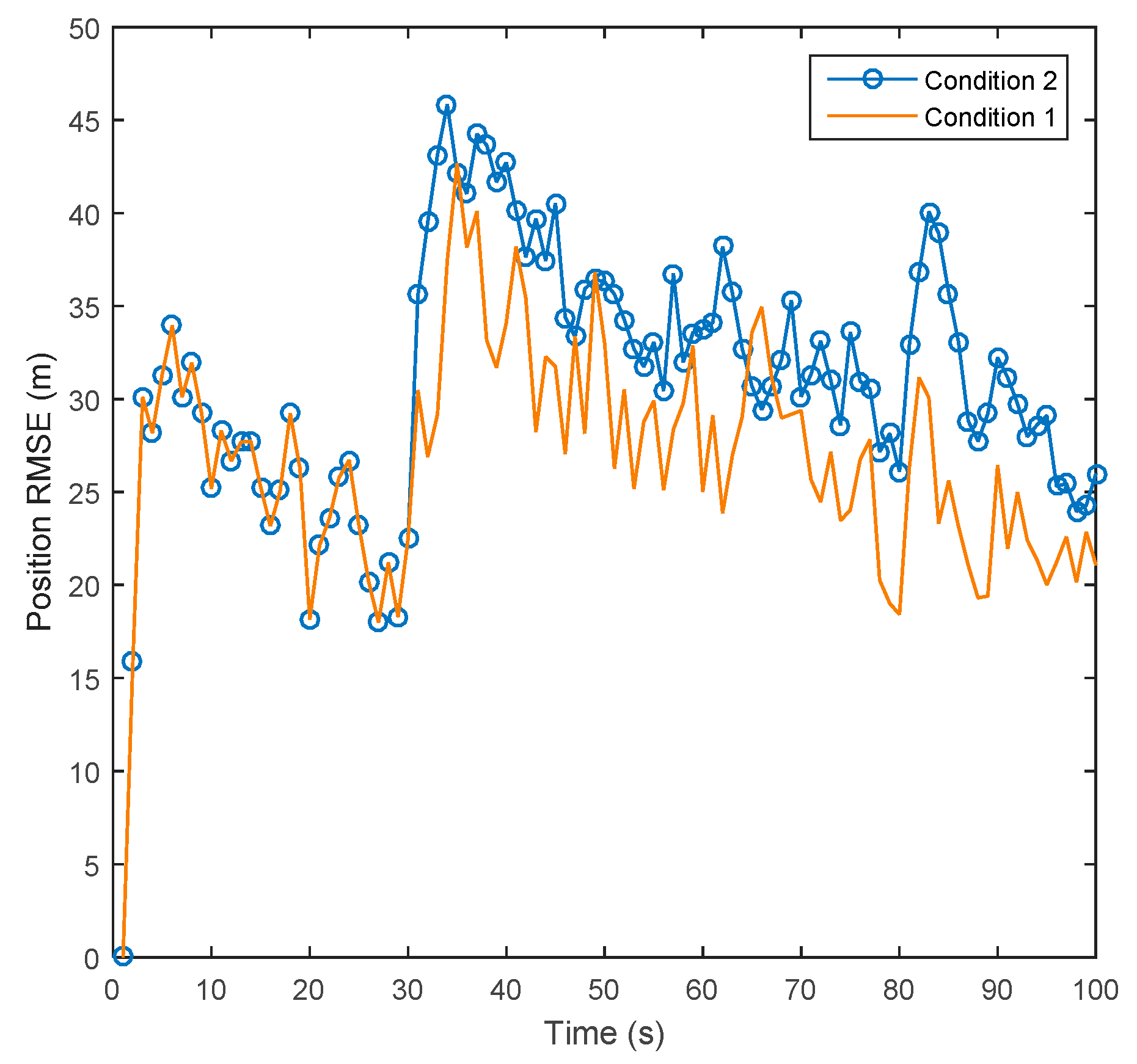
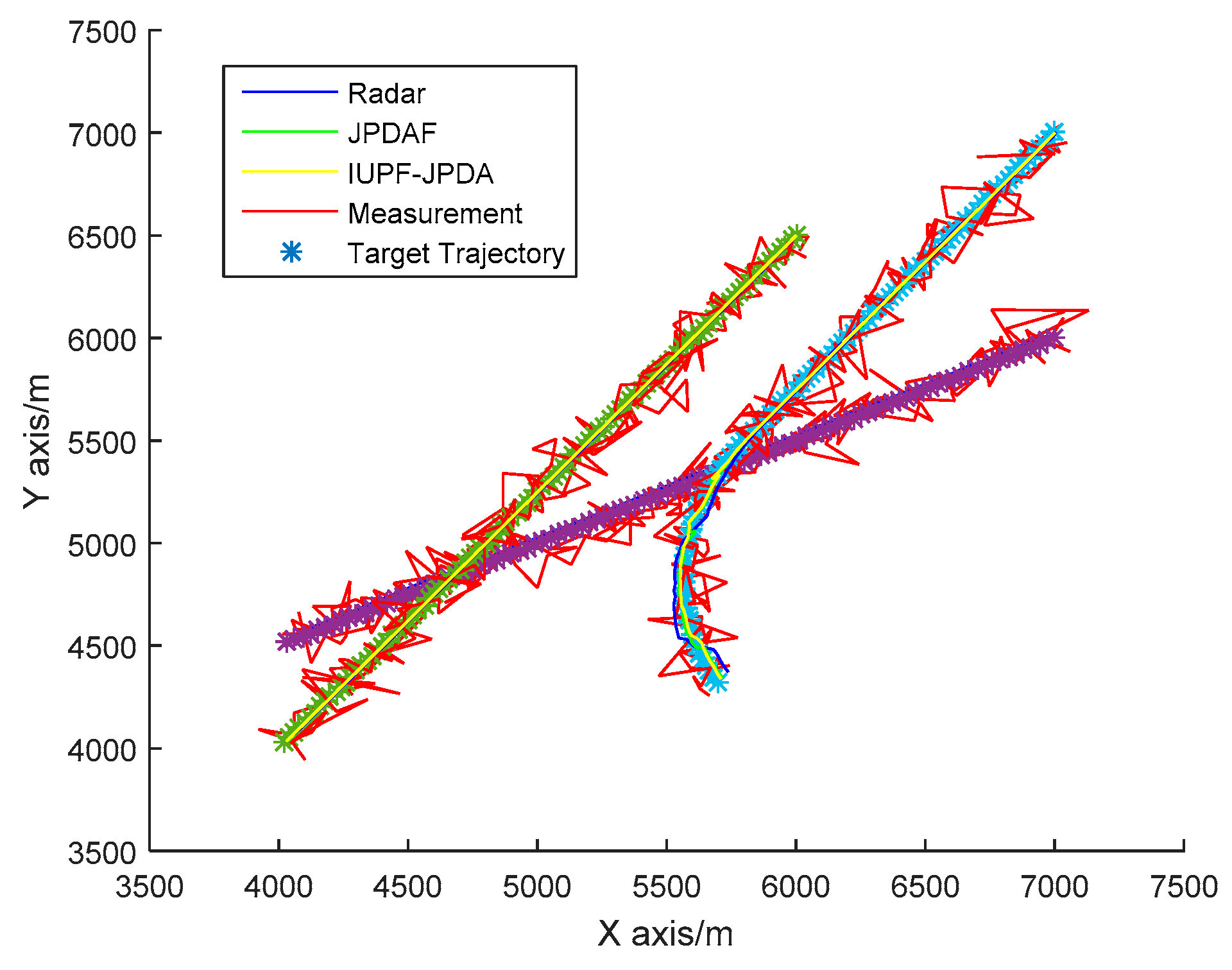
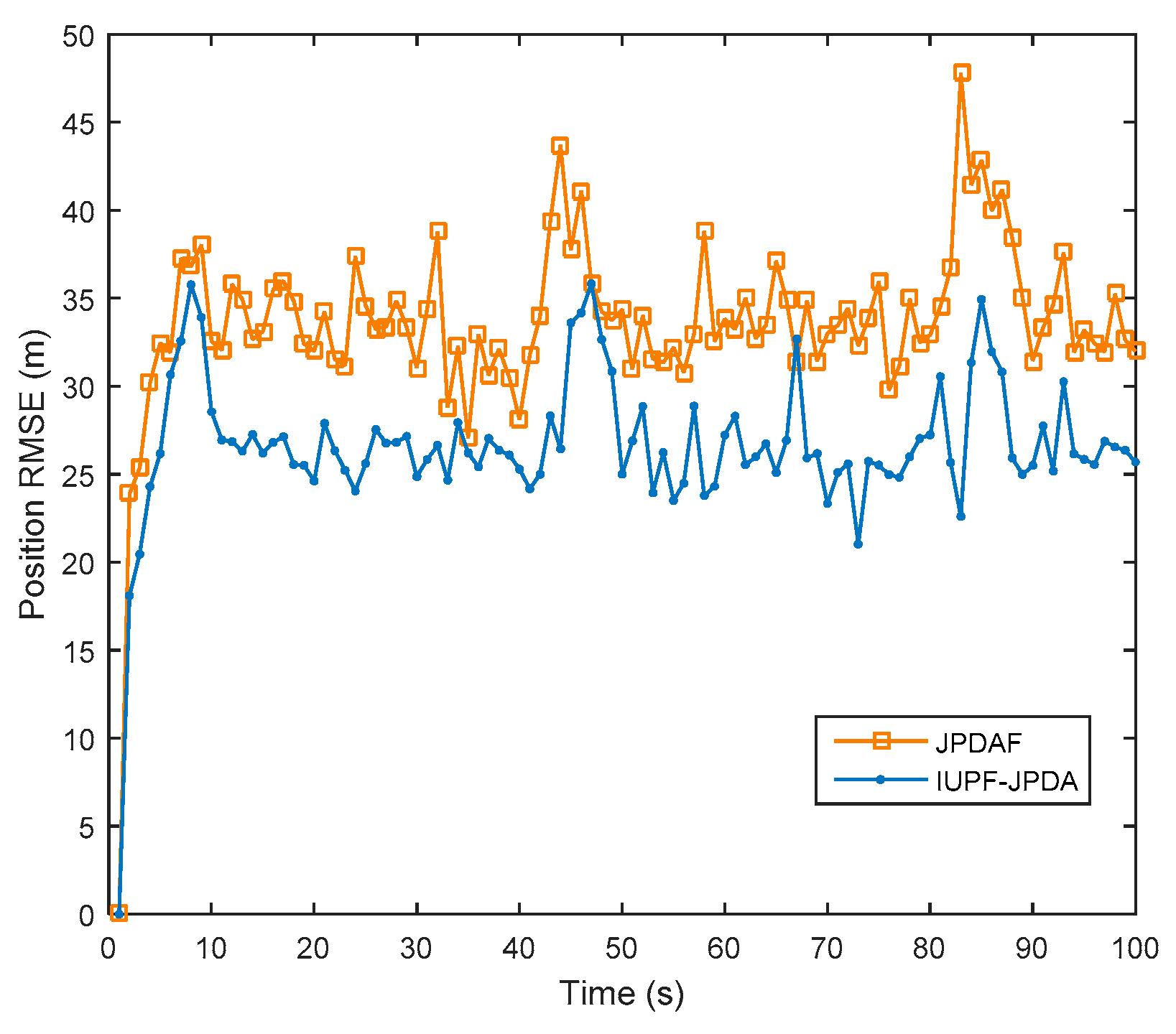

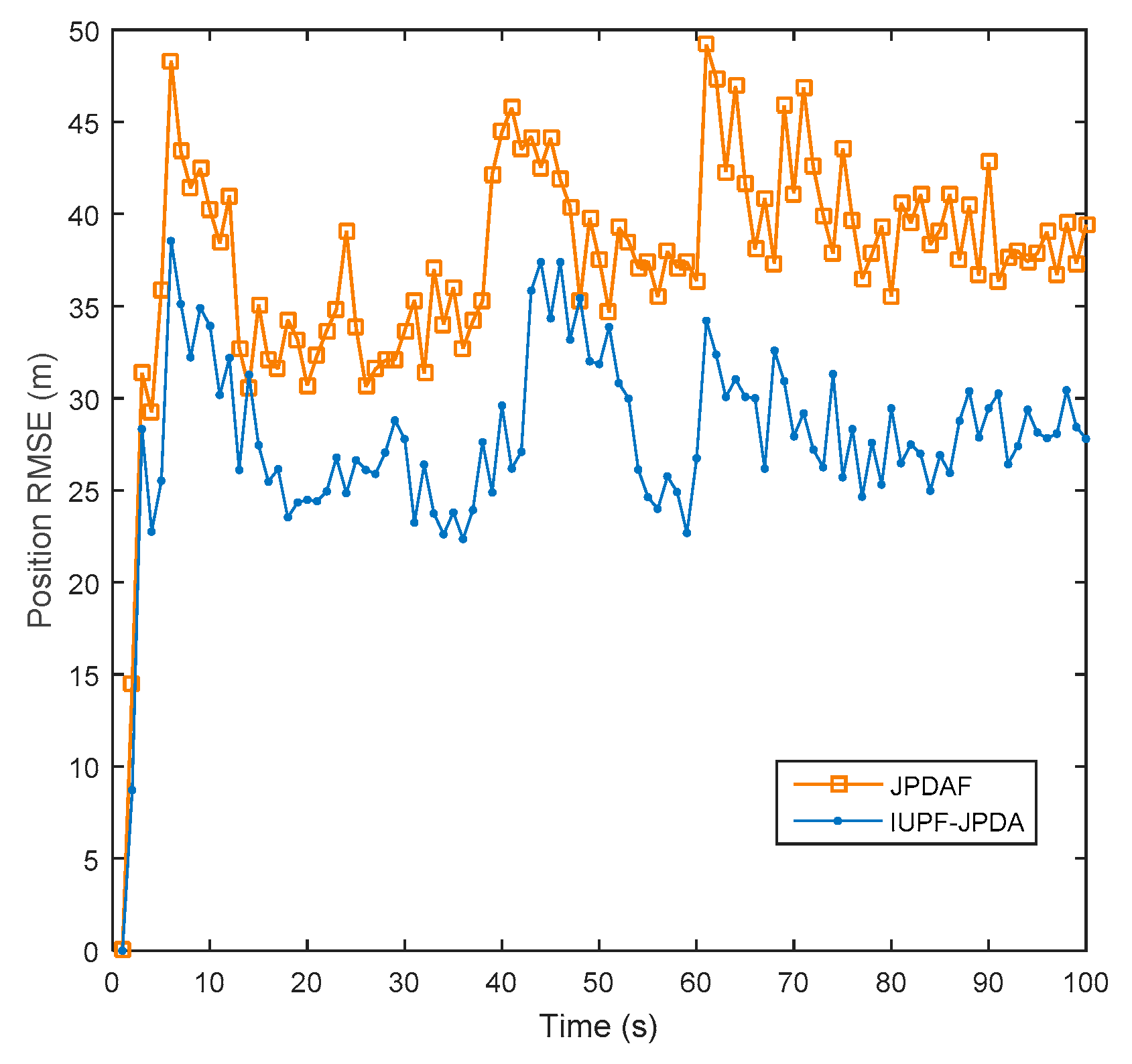
| Algorithm | Radar | Traditional Model | Improved Model |
|---|---|---|---|
| Average RMSE (m) | 57.351 | 32.463 | 25.945 |
| Algorithm | Average Time (s) | Average RMSE (m) |
|---|---|---|
| EKF-PF | 0.602 | 39.316 |
| PF | 0.413 | 53.623 |
| UPF | 1.279 | 33.134 |
| IUPF | 0.68 | 26.214 |
| Time | 10 s | 40 s | 70 s | 90 s | |
|---|---|---|---|---|---|
| Condition 1 | X-RMSE (m) | 27.56 | 34.21 | 29.16 | 28.65 |
| Y-RMSE (m) | 31.22 | 36.12 | 26.36 | 27.41 | |
| 1 | 0.6234 | 0.5621 | 1 | ||
| X-RMSE (m) | 27.56 | 35.21 | 32.67 | 31.98 | |
| Condition 2 | Y-RMSE (m) | 31.22 | 39.31 | 33.54 | 32.13 |
| Algorithm | Radar | JPDAF | IUPF-JPDA | |
|---|---|---|---|---|
| Average RMSE (m) | ||||
| Target1 | 60.35 | 25.46 | 19.54 | |
| Target2 | 55.43 | 21.57 | 17.98 | |
| Target3 | 76.54 | 36.53 | 29.76 | |
Publisher’s Note: MDPI stays neutral with regard to jurisdictional claims in published maps and institutional affiliations. |
© 2020 by the authors. Licensee MDPI, Basel, Switzerland. This article is an open access article distributed under the terms and conditions of the Creative Commons Attribution (CC BY) license (http://creativecommons.org/licenses/by/4.0/).
Share and Cite
Luo, J.; Wang, Z.; Chen, Y.; Wu, M.; Yang, Y. An Improved Unscented Particle Filter Approach for Multi-Sensor Fusion Target Tracking. Sensors 2020, 20, 6842. https://doi.org/10.3390/s20236842
Luo J, Wang Z, Chen Y, Wu M, Yang Y. An Improved Unscented Particle Filter Approach for Multi-Sensor Fusion Target Tracking. Sensors. 2020; 20(23):6842. https://doi.org/10.3390/s20236842
Chicago/Turabian StyleLuo, Junhai, Zhiyan Wang, Yanping Chen, Man Wu, and Yang Yang. 2020. "An Improved Unscented Particle Filter Approach for Multi-Sensor Fusion Target Tracking" Sensors 20, no. 23: 6842. https://doi.org/10.3390/s20236842
APA StyleLuo, J., Wang, Z., Chen, Y., Wu, M., & Yang, Y. (2020). An Improved Unscented Particle Filter Approach for Multi-Sensor Fusion Target Tracking. Sensors, 20(23), 6842. https://doi.org/10.3390/s20236842





